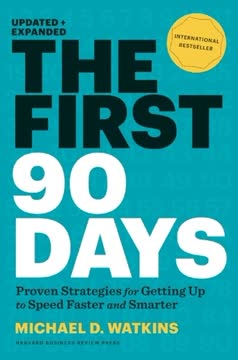نکات کلیدی
1. هوش هیجانی برای رهبری مؤثر ضروری است
"IQ و مهارتهای فنی مهم هستند، اما هوش هیجانی شرط لازم برای رهبری است."
تعریف و اهمیت. هوش هیجانی (EI) به توانایی شناخت، درک و مدیریت احساسات خود و دیگران اشاره دارد. این شامل خودآگاهی، خودتنظیمی، انگیزه، همدلی و مهارتهای اجتماعی است. در رهبری، EI به دلایل متعددی از مهارتهای فنی یا IQ مهمتر است:
- به رهبران امکان میدهد روابط قوی بسازند و تیمهای خود را الهام بخشند
- در پیمایش دینامیکهای اجتماعی پیچیده و سیاستهای سازمانی کمک میکند
- تصمیمگیری بهتری را بهویژه در شرایط فشار بالا ممکن میسازد
- به ایجاد محیط کاری مثبت و فرهنگ سازمانی کمک میکند
تحقیقات و تأثیر. مطالعات نشان دادهاند که رهبران با هوش هیجانی بالا:
- در معیارهای مختلف کسبوکار از همتایان خود پیشی میگیرند
- احتمال بیشتری برای ارتقا و موفقیت در موقعیتهای بالاتر دارند
- تیمهای متعهدتر و پربارتری ایجاد میکنند
- بهتر میتوانند تغییرات و چالشهای سازمانی را مدیریت کنند
2. خودآگاهی پایه هوش هیجانی است
"افرادی که خودآگاهی قوی دارند نه بیش از حد انتقادی هستند و نه بهطور غیرواقعی امیدوار. بلکه با خود و دیگران صادق هستند."
شناخت خود. خودآگاهی توانایی شناخت و درک احساسات، نقاط قوت، ضعفها، ارزشها و تأثیر خود بر دیگران است. این پایه هوش هیجانی را تشکیل میدهد زیرا به رهبران امکان میدهد:
- محرکها و واکنشهای احساسی خود را شناسایی کنند
- تشخیص دهند که رفتارشان چگونه بر دیگران تأثیر میگذارد
- تصمیمات آگاهانهتری بر اساس ارزشها و اهداف خود بگیرند
- بازخورد بگیرند و بهطور مداوم بهبود یابند
توسعه خودآگاهی. رهبران میتوانند خودآگاهی خود را از طریق:
- تأمل منظم و نوشتن در دفترچه
- درخواست بازخورد صادقانه از همکاران، زیردستان و مافوقها
- تمرین ذهنآگاهی و مدیتیشن
- شرکت در ارزیابیهای شخصیتی و فرآیندهای بازخورد 360 درجه
3. خودتنظیمی به رهبران امکان کنترل احساساتشان را میدهد
"خودتنظیمی، که مانند یک گفتگوی درونی مداوم است، جزء هوش هیجانی است که ما را از اسیر احساساتمان بودن آزاد میکند."
کنترل احساسی. خودتنظیمی توانایی مدیریت و کنترل احساسات خود، بهویژه در موقعیتهای چالشبرانگیز یا استرسزا است. این به رهبران امکان میدهد:
- در شرایط فشار آرام بمانند
- بهوضوح فکر کنند و تصمیمات منطقی بگیرند
- به شرایط متغیر سازگار شوند
- محیط کاری پایدار و مثبتی ایجاد کنند
تکنیکهای خودتنظیمی. رهبران میتوانند خودتنظیمی خود را با:
- تمرین تنفس عمیق و تکنیکهای آرامشبخش دیگر
- شناسایی و به چالش کشیدن الگوهای فکری منفی
- توسعه مکانیزمهای مقابلهای سالم برای استرس
- ایجاد وقفه بین محرکهای احساسی و پاسخها
- پرورش ذهنیت رشد و دیدن چالشها بهعنوان فرصتها
4. انگیزه رهبران را به دستیابی به فراتر از انتظارات سوق میدهد
"اگر یک ویژگی وجود داشته باشد که تقریباً همه رهبران مؤثر دارند، آن انگیزه است. آنها به دستیابی به فراتر از انتظارات خود و دیگران سوق داده میشوند."
انگیزه درونی. انگیزه در زمینه هوش هیجانی به یک انگیزه درونی برای دستیابی و برتری اشاره دارد. رهبران با انگیزه:
- استانداردهای بالایی برای خود و تیمهایشان تعیین میکنند
- در مواجهه با موانع و شکستها پافشاری میکنند
- دیگران را از طریق اشتیاق خود الهام بخشیده و انرژی میدهند
- بهطور مداوم به دنبال فرصتهای رشد و بهبود هستند
پرورش انگیزه. رهبران میتوانند انگیزه خود را با:
- روشن کردن ارزشهای شخصی و حرفهای خود
- تعیین اهداف چالشبرانگیز اما قابل دستیابی
- جشن گرفتن پیروزیها و نقاط عطف کوچک
- احاطه کردن خود با افراد با انگیزه دیگر
- تأمل منظم بر پیشرفت خود و تنظیم رویکردشان
5. همدلی به رهبران امکان درک و ارتباط با دیگران را میدهد
"همدلی به معنای در نظر گرفتن احساسات کارکنان همراه با عوامل دیگر در فرآیند تصمیمگیری هوشمندانه است."
ارتباط احساسی. همدلی توانایی درک و به اشتراک گذاشتن احساسات دیگران است. این برای رهبران حیاتی است زیرا به آنها امکان میدهد:
- اعتماد و ارتباط با اعضای تیم بسازند
- دیدگاهها و تجربیات متنوع را درک کنند
- تصمیمات آگاهانهتر و دلسوزانهتری بگیرند
- محیط کاری حمایتی و فراگیر ایجاد کنند
توسعه همدلی. رهبران میتوانند همدلی خود را با:
- گوش دادن فعال و توجه کامل به دیگران
- تمرین تمرینهای دیدگاهگیری
- جستجوی تجربیات و تعاملات متنوع
- نشان دادن علاقه واقعی به زندگی و نگرانیهای دیگران
- تأیید و اعتبار دادن به احساسات دیگران
6. مهارتهای اجتماعی به رهبران کمک میکند روابط را بسازند و حفظ کنند
"مهارت اجتماعی دوستی با هدف است: حرکت دادن افراد در جهتی که میخواهید، چه توافق بر روی یک استراتژی بازاریابی جدید باشد یا اشتیاق به یک محصول جدید."
اثربخشی بینفردی. مهارتهای اجتماعی شامل مجموعهای از تواناییها است که به رهبران امکان میدهد بهطور مؤثر با دیگران تعامل کنند. این شامل:
- ارتباط: بیان واضح ایدهها و گوش دادن فعال به دیگران
- تأثیرگذاری: متقاعد کردن و الهام بخشیدن به دیگران برای اقدام
- مدیریت تعارض: حل اختلافات و یافتن راهحلهای برد-برد
- همکاری: کار مؤثر در تیمها و پرورش همکاری
- ساخت و حفظ روابط: ایجاد و حفظ ارتباطات مثبت
بهبود مهارتهای اجتماعی. رهبران میتوانند مهارتهای اجتماعی خود را با:
- تمرین گوش دادن فعال و ارتباط همدلانه
- جستجوی فرصتها برای سخنرانی عمومی و ارائهها
- شرکت در رویدادهای شبکهسازی و انجمنهای حرفهای
- داوطلب شدن برای پروژههای بینوظیفهای و فعالیتهای تیمسازی
- درخواست بازخورد در مورد تعاملات بینفردی خود و تنظیم آنها
7. هوش هیجانی میتواند توسعه یابد و بهبود یابد
"هوش هیجانی میتواند آموخته شود. این فرآیند آسان نیست. زمان و بیش از همه، تعهد میطلبد. اما مزایایی که از داشتن هوش هیجانی بهخوبی توسعهیافته به دست میآید، هم برای فرد و هم برای سازمان، ارزش تلاش را دارد."
ذهنیت رشد. در حالی که برخی جنبههای هوش هیجانی ممکن است دارای یک جزء ژنتیکی باشند، عمدتاً مهارتی است که میتواند در طول زمان توسعه یابد و بهبود یابد. این ذهنیت رشد برای رهبرانی که میخواهند EI خود را بهبود بخشند ضروری است.
استراتژیهای بهبود. رهبران میتوانند هوش هیجانی خود را از طریق:
- تأمل و نوشتن در دفترچه برای افزایش خودآگاهی
- جستجوی بازخورد منظم از منابع متنوع
- تمرین ذهنآگاهی و مدیتیشن برای بهبود خودتنظیمی
- شرکت در روابط مربیگری یا مشاوره
- شرکت در برنامههای آموزشی هوش هیجانی
- تعیین اهداف خاص برای بهبود هر جزء EI
- ارزیابی منظم پیشرفت و تنظیم استراتژیها در صورت نیاز
8. تابآوری کلید غلبه بر ناملایمات در رهبری است
"افراد تابآور سه ویژگی تعریفکننده دارند: آنها بهطور خونسرد واقعیتهای سختی که با آنها روبرو هستند را میپذیرند. آنها در زمانهای وحشتناک معنا پیدا میکنند. و آنها توانایی عجیبی برای بداههسازی دارند، با هر چیزی که در دسترس است."
بازگشت به حالت عادی. تابآوری توانایی بازیابی از شکستها، سازگاری با تغییر و ادامه دادن در مواجهه با ناملایمات است. این ویژگی برای رهبرانی که باید در محیطهای کسبوکار پیچیده و چالشبرانگیز حرکت کنند، حیاتی است.
ساختن تابآوری. رهبران میتوانند تابآوری خود را با:
- توسعه دیدگاه واقعبینانه و خوشبینانه
- پرورش شبکه حمایتی قوی
- تمرین مراقبت از خود و تکنیکهای مدیریت استرس
- یادگیری از شکستها و ناملایمات
- تمرکز بر آنچه قابل کنترل است و پذیرش آنچه نیست
- حفظ حس هدف و معنا در کار خود
- توسعه مهارتهای حل مسئله و تفکر خلاق
9. بازخورد برای رشد و توسعه ضروری است
"برای تصمیمات مهم، ما به یک روش ساختاریافته و عمدی برای شناسایی منابع احتمالی تعصب نیاز داریم—آن شرایط پرچم قرمز—و ما باید فرآیند تصمیمگیری گروهی را تقویت کنیم."
بهبود مستمر. بازخورد ابزاری حیاتی برای رهبران است تا بینشی در مورد عملکرد، نقاط کور و زمینههای بهبود خود کسب کنند. این به:
- افزایش خودآگاهی
- شناسایی نقاط قوت و ضعف
- همراستایی رفتار با اهداف سازمانی
- پرورش فرهنگ ارتباط باز و رشد
فرآیندهای بازخورد مؤثر. رهبران میتوانند فرهنگ بازخورد را با:
- اجرای فرآیندهای بازخورد 360 درجه منظم
- تشویق ارتباط باز و صادقانه در تیمها
- ارائه بازخورد خاص و قابل اقدام به دیگران
- جستجوی بازخورد بهطور فعال و پاسخگویی سازنده
- ایجاد امنیت روانی برای دادن و دریافت بازخورد
- استفاده از بازخورد بهعنوان ابزاری برای توسعه، نه تنبیه
10. بیادبی در محیط کار هزینههای قابل توجهی دارد
"تقریباً همه کسانی که بیادبی در محیط کار را تجربه میکنند بهطور منفی واکنش نشان میدهند، در برخی موارد بهطور آشکار تلافی میکنند."
خطرات پنهان. بیادبی در محیط کار، از جمله بیاحترامی، بیادبی و رفتار بیادبانه، میتواند تأثیرات منفی قابل توجهی بر سازمانها داشته باشد:
- کاهش بهرهوری و خلاقیت
- افزایش ترک کار و غیبت
- آسیب به روابط با مشتریان
- سطوح بالاتر استرس و فرسودگی
- کاهش همکاری و کار تیمی
ترویج ادب. رهبران میتوانند محیط کاری مدنیتری را با:
- مدلسازی رفتار محترمانه و مسئولیتپذیری دیگران
- تعیین هنجارها و انتظارات واضح برای ادب
- رسیدگی به بیادبی بهطور سریع و مداوم
- شناسایی و پاداش دادن به رفتار مدنی
- ارائه آموزش در مورد هوش هیجانی و مهارتهای بینفردی
- ایجاد کانالهایی برای گزارش و رسیدگی به بیادبی
11. رهبران جوان باید جاهطلبی را با بلوغ احساسی متعادل کنند
"در نقطهای از حرفه یک مدیر جوان، معمولاً در سطح معاون رئیس، استعداد خام و جاهطلبی مصمم کمتر از توانایی تأثیرگذاری و متقاعد کردن اهمیت پیدا میکند."
چالش توسعهای. بسیاری از رهبران جوان و با پتانسیل بالا با یک چالش حیاتی روبرو هستند: متعادل کردن جاهطلبی و مهارتهای فنی خود با توسعه هوش هیجانی و اثربخشی بینفردی.
استراتژیهای رشد. سازمانها و رهبران جوان میتوانند این چالش را با:
- ارائه فرصتهای مربیگری و مشاوره
- ارائه وظایف چالشی که مهارتهای رهبری را توسعه میدهند
- اجرای فرآیندهای بازخورد قوی
- تشویق به تأمل شخصی و توسعه فردی
- متعادل کردن آموزش فنی با توسعه هوش هیجانی
- ایجاد برنامههای توسعه رهبری که بر EI تمرکز دارند
- پرورش فرهنگی که هم عملکرد و هم بلوغ احساسی را ارزش مینهد
آخرین بهروزرسانی::
FAQ
What's "On Emotional Intelligence" by Harvard Business Review about?
- Collection of Articles: "On Emotional Intelligence" is a compilation of articles from the Harvard Business Review that focus on the concept of emotional intelligence (EI) and its application in leadership and management.
- Key Topics Covered: The book covers various aspects of emotional intelligence, including self-awareness, self-regulation, motivation, empathy, and social skills, and how these components contribute to effective leadership.
- Practical Insights: It provides practical insights and strategies for developing emotional intelligence in individuals and teams, aiming to enhance workplace performance and personal growth.
- Contributors: The book features contributions from renowned authors and experts in the field, such as Daniel Goleman, who is known for popularizing the concept of emotional intelligence.
Why should I read "On Emotional Intelligence" by Harvard Business Review?
- Enhance Leadership Skills: The book offers valuable insights into how emotional intelligence can improve leadership effectiveness, making it a crucial read for current and aspiring leaders.
- Improve Workplace Dynamics: Understanding and applying the principles of emotional intelligence can lead to better team collaboration, communication, and conflict resolution.
- Personal Development: Readers can gain tools and strategies to develop their own emotional intelligence, leading to personal growth and improved interpersonal relationships.
- Expert Perspectives: The book compiles articles from leading experts, providing a comprehensive and authoritative perspective on the importance of emotional intelligence in the workplace.
What are the key takeaways of "On Emotional Intelligence"?
- Importance of EI in Leadership: Emotional intelligence is a critical factor in distinguishing great leaders from merely good ones, as it enhances decision-making and relationship-building.
- Components of EI: The book emphasizes the five key components of emotional intelligence: self-awareness, self-regulation, motivation, empathy, and social skills.
- EI Can Be Developed: Emotional intelligence is not fixed; it can be cultivated through practice, feedback, and a commitment to personal growth.
- Impact on Performance: High levels of emotional intelligence in leaders and teams lead to improved performance, innovation, and organizational success.
How does "On Emotional Intelligence" define emotional intelligence?
- Self-awareness: Understanding one's own emotions, strengths, weaknesses, and values, and recognizing their impact on others.
- Self-regulation: The ability to control or redirect disruptive emotions and impulses and adapt to changing circumstances.
- Motivation: A passion for work that goes beyond money or status, driven by a desire to achieve for the sake of achievement.
- Empathy and Social Skills: The ability to understand others' emotions and build strong relationships, facilitating collaboration and conflict resolution.
What are the best quotes from "On Emotional Intelligence" and what do they mean?
- "What distinguishes great leaders from merely good ones? It isn’t IQ or technical skills. It’s emotional intelligence." This quote highlights the book's central thesis that emotional intelligence is the key differentiator in effective leadership.
- "Emotional intelligence is the sine qua non of leadership." This emphasizes that without emotional intelligence, other leadership skills are insufficient for true effectiveness.
- "Resonant leaders use self-awareness to gauge their own moods accurately, and they intuitively know how they are affecting others." This underscores the importance of self-awareness in leadership, allowing leaders to manage their impact on their teams.
- "Emotional intelligence can be learned." This quote reassures readers that emotional intelligence is not innate but can be developed through intentional effort and practice.
How can I develop emotional intelligence according to "On Emotional Intelligence"?
- Practice Self-awareness: Regularly reflect on your emotions and their impact on your behavior and decisions. Seek feedback from others to gain a clearer understanding of your strengths and weaknesses.
- Enhance Self-regulation: Develop strategies to manage stress and control impulsive reactions. Practice staying calm and composed in challenging situations.
- Cultivate Empathy: Actively listen to others and try to understand their perspectives and emotions. Show genuine interest and concern for their well-being.
- Build Social Skills: Work on effective communication, conflict resolution, and relationship-building. Engage in team activities and seek opportunities to collaborate with others.
What role does emotional intelligence play in team dynamics as discussed in "On Emotional Intelligence"?
- Trust and Collaboration: Emotional intelligence fosters trust among team members, leading to better collaboration and cooperation.
- Conflict Resolution: Teams with high emotional intelligence are better equipped to handle conflicts constructively, maintaining a positive and productive work environment.
- Innovation and Creativity: Emotionally intelligent teams are more open to diverse perspectives and ideas, enhancing creativity and innovation.
- Group Norms: Establishing emotionally intelligent norms within teams can lead to improved performance and a stronger sense of group identity and efficacy.
How does "On Emotional Intelligence" suggest handling negative emotions in the workplace?
- Acknowledge and Accept: Recognize and accept negative emotions rather than suppressing them. Understand that they are a natural part of the human experience.
- Label Emotions: Identify and label your emotions to gain clarity and perspective, reducing their intensity and impact.
- Reflect and Learn: Use negative emotions as opportunities for reflection and learning. Consider what they reveal about your values and goals.
- Constructive Action: Channel negative emotions into constructive actions that align with your values and contribute to personal and organizational growth.
What strategies does "On Emotional Intelligence" offer for improving self-regulation?
- Mindfulness Practices: Engage in mindfulness exercises to increase awareness of your emotional triggers and responses, helping you manage them more effectively.
- Stress Management Techniques: Develop techniques to manage stress, such as deep breathing, meditation, or physical exercise, to maintain emotional balance.
- Impulse Control: Practice delaying immediate reactions to allow time for thoughtful consideration and response.
- Adaptability: Cultivate flexibility and openness to change, enabling you to adjust your behavior and strategies as needed.
How does "On Emotional Intelligence" address the development of empathy in leaders?
- Active Listening: Encourage leaders to practice active listening, focusing on understanding the speaker's perspective without interrupting or judging.
- Perspective-Taking: Teach leaders to consider situations from others' viewpoints, fostering a deeper understanding of their emotions and motivations.
- Emotional Support: Promote the importance of providing emotional support and validation to team members, strengthening relationships and trust.
- Cultural Sensitivity: Highlight the need for cultural sensitivity and awareness in diverse teams, enhancing empathy and reducing misunderstandings.
What are the potential pitfalls of lacking emotional intelligence in leadership as highlighted in "On Emotional Intelligence"?
- Poor Decision-Making: Leaders without emotional intelligence may struggle with decision-making, as they fail to consider the emotional impact on themselves and others.
- Conflict Escalation: A lack of empathy and self-regulation can lead to unresolved conflicts and a toxic work environment.
- Low Employee Engagement: Leaders who are not emotionally intelligent may struggle to connect with their teams, resulting in low morale and disengagement.
- Stunted Growth: Without emotional intelligence, leaders may find it challenging to adapt to change and drive innovation, hindering personal and organizational growth.
How does "On Emotional Intelligence" suggest organizations can foster emotional intelligence among employees?
- Training Programs: Implement training programs focused on developing emotional intelligence skills, such as self-awareness, empathy, and social skills.
- Feedback Mechanisms: Establish regular feedback mechanisms, such as 360-degree reviews, to help employees gain insights into their emotional competencies.
- Supportive Culture: Create a supportive organizational culture that values emotional intelligence and encourages open communication and collaboration.
- Leadership Development: Incorporate emotional intelligence into leadership development programs, ensuring that future leaders possess the necessary skills to succeed.
نقد و بررسی
کتاب ده مقاله برتر HBR درباره هوش هیجانی مجموعهای از مقالات در زمینه رهبری و هوش هیجانی است. منتقدان این کتاب را بینشافزا و حاوی توصیههای عملی برای مدیران و رهبران دانستهاند. این کتاب موضوعاتی مانند تابآوری، بازخورد و پویایی گروهی را پوشش میدهد. برخی از خوانندگان آن را تکراری یا خشک توصیف کردهاند، در حالی که دیگران از فرم مختصر و کاربردی آن تمجید کردهاند. بسیاری از تمرکز بر مهارتهای نرم و اهمیت آنها در محیط کار قدردانی کردهاند. بهطور کلی، این کتاب به عنوان منبعی ارزشمند برای کسانی که به دنبال بهبود هوش هیجانی و تواناییهای رهبری خود هستند، محسوب میشود.
Similar Books























